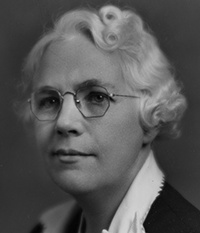Related Research Articles

Experimental psychology refers to work done by those who apply experimental methods to psychological study and the underlying processes. Experimental psychologists employ human participants and animal subjects to study a great many topics, including sensation & perception, memory, cognition, learning, motivation, emotion; developmental processes, social psychology, and the neural substrates of all of these.

Margaret Floy Washburn, was a leading American psychologist in the early 20th century, was best known for her experimental work in animal behavior and motor theory development. She was the first woman to be granted a PhD in psychology (1894); the second woman, after Mary Whiton Calkins, to serve as president of the American Psychological Association (1921); and the first woman elected to the Society of Experimental Psychologists. A Review of General Psychology survey, published in 2002, ranked Washburn as the 88th most cited psychologist of the 20th century, tied with John Garcia, James J. Gibson, David Rumelhart, Louis Leon Thurstone, and Robert S. Woodworth.
Catharine Morris Cox Miles was an American psychologist known for her work on intelligence and genius. Born in San Jose, CA, to Lydia Shipley Bean and Charles Elwood Cox. In 1927 married psychologist Walter Richard Miles. Her sister was classics scholar and Quaker administrator Anna Cox Brinton.

Mental rotation is the ability to rotate mental representations of two-dimensional and three-dimensional objects as it is related to the visual representation of such rotation within the human mind. There is a relationship between areas of the brain associated with perception and mental rotation. There could also be a relationship between the cognitive rate of spatial processing, general intelligence and mental rotation.

Thought Field Therapy (TFT) is a fringe psychological treatment developed by American psychologist Roger Callahan. Its proponents say that it can heal a variety of mental and physical ailments through specialized "tapping" with the fingers at meridian points on the upper body and hands. The theory behind TFT is a mixture of concepts "derived from a variety of sources. Foremost among these is the ancient Chinese philosophy of chi, which is thought to be the 'life force' that flows throughout the body". Callahan also bases his theory upon applied kinesiology and physics. There is no scientific evidence that TFT is effective, and the American Psychological Association has stated that it "lacks a scientific basis" and consists of pseudoscience.

There are many cultural aspects surrounding how societies view menstruation. Different cultures view menstruation in different ways. The basis of many conduct norms and communication about menstruation in western industrial societies is the belief that menstruation should remain hidden. By contrast, in some hunter-gatherer societies, menstrual observances are viewed in a positive light, without any connotation of uncleanness.

Florence Laura Goodenough was an American psychologist and professor at the University of Minnesota who studied child intelligence and various problems in the field of child development. She was president of the Society for Research in Child Development from 1946-1947. She is best known for published book The Measurement of Intelligence, where she introduced the Goodenough Draw-A-Man test to assess intelligence in young children through nonverbal measurement. She is noted for developing the Minnesota Preschool Scale. In 1931 she published two notable books titled Experimental Child Study and Anger in Young Children which analyzed the methods used in evaluating children. She wrote the Handbook of Child Psychology in 1933, becoming the first known psychologist to critique ratio I.Q.

Leta Stetter Hollingworth was an American psychologist, educator, and feminist. Hollingworth also made contributions in psychology of women; clinical psychology; and educational psychology. She is best known for her work with gifted children.

Harry Levi Hollingworth was one of the first psychologists to bring psychology into the advertising world, as well as a pioneer in applied psychology.

The variability hypothesis, also known as the greater male variability hypothesis, is the hypothesis that males generally display greater variability in traits than females do.
Anne Anastasi was an American psychologist best known for her pioneering development of psychometrics. Her generative work, Psychological Testing, remains a classic text in which she drew attention to the individual being tested and therefore to the responsibilities of the testers. She called for them to go beyond test scores, to search the assessed individual's history to help them to better understand their own results and themselves.
Feminist psychology is a form of psychology centered on social structures and gender. Feminist psychology critiques historical psychological research as done from a male perspective with the view that males are the norm. Feminist psychology is oriented on the values and principles of feminism.
Mary Cheves West Perky (1874–1940) was an American psychologist who was one of the many aspiring female student psychologists who studied under Edward B. Titchener at Cornell University. Perky received her Ph.D. in 1910 and her dissertation was a detailed study of visual, auditory, and olfactory imagery that had a considerable impact with being cited by name in the title of an article as recently as 2012. In 1910, she performed the "Banana Experiment," which led to the discovery of the phenomenon known as the Perky Effect, which examines the link between mental imagery and visual perception.
Alice H. Eagly is the James Padilla Chair of Arts and Sciences Emerita and emerita professor of psychology at Northwestern University. She is also a fellow at the Institute of Policy Research at Northwestern University. Her primary research focus is social psychology, as well as personality psychology and Industrial Organizational Psychology. She was elected as a member of the National Academy of Sciences in 2022.
Theodora Mead Abel (1899–1998) was an American clinical psychologist and educator, who used innovative ideas by combining sociology and psychology. She was a pioneer in cross-cultural psychology.
Sex differences in human intelligence have long been a topic of debate among researchers and scholars. It is now recognized that there are no significant sex differences in general intelligence, though particular subtypes of intelligence vary somewhat between sexes.

Georgene Hoffman Seward, an early feminist psychologist, was best known for her research on sex roles and sex behavior. Having experienced much sex discrimination in academia herself, she dedicated her life to researching sex differences and minority experiences, and encouraging women to pursue leadership in science.
Nancy Bayley was an American psychologist best known for her work on the Berkeley Growth Study and the subsequent Bayley Scales of Infant Development. Originally interested in teaching, she eventually gained interest in psychology, for which she went on to obtain her Ph.D. in from the University of Iowa in 1926. Within two years, Bayley had accepted a position at the Institute for Child Welfare at the University of California, Berkeley. There she began the longitudinal Berkeley Growth Study, which worked to create a guide of physical and behavioral growth across development. Bayley also examined the development of cognitive and motor functions in children, leading to her belief that intelligence evolves over the course of child development. In 1954, Bayley began working on the National Collaborative Perinatal Project (NCPP) with the National Institute of Mental Health (NIMH), where she applied her work to infants. After retiring in 1968, Bayley synthesized her work and published the Bayley Scales of Infant Development, which is still in use today. For her efforts in the field of psychology, Bayley became the first woman to receive the Distinguished Scientific Contribution award from the American Psychological Association (APA), of which she was a fellow, amongst other honorary awards. Bayley was also a member of the American Association for the Advancement of Science. She died at the age of 95 from a respiratory illness.
Tsuruko Haraguchi was a Japanese psychologist and the first Japanese woman to receive a Doctor of Philosophy.
Helen Bradford Thompson Woolley was an American psychologist, known for her contributions to the educational sector, groundbreaking research on sex differences and rigorous research methods. Woolley's interest in scientific inquiry was prompted by the work of her father, Paul Thompson, who was an inventor. Woolley's academic achievement and resultant scholarship allowed her to pursue studies in psychology at the University of Chicago.
References
- 1 2 3 4 5 6 Stetter-Hollingworth, L. (1914). Functional periodicity: An experimental study of the mental and motor abilities of women during menstruation. Contributions to Education, 69.
- 1 2 3 4 5 6 7 8 9 10 Fancher, R., & Rutherford, A. (2012). Pioneers of psychology. (4th ed.). New York, NY: W.W. Norton & Company, Inc.
- ↑ Green, C.D. (2000). Functional periodicity. Classics in the History of Psychology, 1-52.